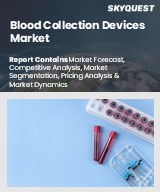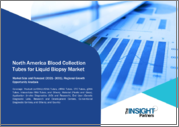
|
시장보고서
상품코드
1800305
세계의 채혈관 시장 예측(2025-2030년)Blood Collection Tubes Market - Forecasts fom 2025 to 2030 |
||||||
세계의 채혈관 시장은 CAGR 5.75%로 확대되어 2025년 35억 300만 달러에서 2030년까지 46억 3,300만 달러로 성장할 것으로 예측됩니다.
세계의 채혈관 시장은 만성 질환의 유병률 상승, 고령화, 외과 수술 증가 등을 배경으로 큰 성장을 이루려고 합니다. 특히 당뇨병이나 암 등, 빈번한 진단이 필요한 질환에 대한 혈액 검사나 보존의 요구가 높아지고 있는 것이 시장의 추풍이 되고 있습니다. 효율성과 사용성 향상 등 튜브 설계의 기술적 진보가 수요를 더욱 밀어 올리고 있습니다. 제조 비용의 높이와 규제의 복잡성 등의 과제에도 불구하고, 시장은 견고한 의료 인프라에 지지되고 있으며, 미국은 선진적인 의료 에코시스템과 검사량이 많기 때문에 압도적인 시장으로 부상하고 있습니다.
시장 성장 촉진요인
당뇨병 및 암과 같은 만성 질환의 이환율 증가는 진단 및 모니터링을 위한 빈번한 혈액 검사를 필요로 하는 주요 촉진요인입니다. 세계보건기구(WHO)는 120만명의 소아를 포함한 1,020만명의 결핵환자를 세계에 보고하여 신뢰성 높은 채혈시스템 수요를 부각시켰습니다. 또한 수술 건수 증가도 시장의 성장을 뒷받침하고 있으며, 채혈관은 수술 전 및 수술 후 검사에 필수적입니다. 예를 들어, 포르투갈, 덴마크, 노르웨이, 아일랜드와 같은 유럽 국가에서는 수술 건수가 많아 효율적인 채혈 솔루션의 필요성을 강조하고 있습니다. 게다가 2023년 1월에 출시된 BD의 Vacutainer(R) Serum Tube with K2EDTA와 같은 혈청 분리를 위한 기술 진보는 사용성을 향상시키고 외과적 용도를 지원하며 시장 확대를 촉진하고 있습니다. WHO의 2023년 6월 데이터는 1억 1,850만개가 수집되었으며, 세계 헌혈 증가는 안전한 보관 및 검사를 보장하기 위한 전용 튜브 수요를 더욱 증폭시키고 있습니다.
목차
제1장 서론
- 시장 개요
- 시장의 정의
- 분석 범위
- 시장 세분화
- 통화
- 전제조건
- 기준연도과 예측연도의 타임라인
제2장 분석 방법
- 분석 디자인
- 분석 데이터
- 검증
제3장 주요 요약
- 주요 분석 결과
제4장 시장 역학
- 시장 성장 촉진요인
- 시장 성장 억제요인
- Porter's Five Forces 분석
- 업계 밸류체인 분석
제5장 채혈관 시장 분석 : 제품 유형별
- 소개
- EDTA 튜브
- 헤파린 튜브
- 헤파린 혈장 분리 튜브
- 혈청 분리관
- 기타
제6장 채혈관 시장 분석 : 재료별
- 소개
- 플라스틱
- 폴리에틸렌테레프탈레이트
- 폴리프로필렌
- 폴리스티렌
- 기타
- 유리
제7장 채혈관 시장 분석 : 최종 사용자별
- 소개
- 진단센터
- 병원 및 진료소
- 연구개발센터
제8장 채혈관 시장의 분석 : 지역별
- 소개
- 북미
- 제품 유형별
- 재료유형별
- 최종 사용자별
- 국가별
- 미국
- 캐나다
- 멕시코
- 남미
- 제품 유형별
- 재료유형별
- 최종 사용자별
- 국가별
- 브라질
- 아르헨티나
- 기타
- 유럽
- 제품 유형별
- 재료유형별
- 최종 사용자별
- 국가별
- 영국
- 독일
- 프랑스
- 스페인
- 기타
- 중동 및 아프리카
- 제품 유형별
- 재료유형별
- 최종 사용자별
- 국가별
- 사우디아라비아
- 아랍에미리트(UAE)
- 이스라엘
- 기타
- 아시아태평양
- 제품 유형별
- 재료유형별
- 최종 사용자별
- 국가별
- 일본
- 중국
- 인도
- 한국
- 인도네시아
- 대만
- 기타
제9장 경쟁 환경과 분석
- 주요 기업과 전략 분석
- 신흥기업과 시장수익성
- 기업 합병인수(M&A), 합의, 사업 협력
- 벤더 경쟁력 매트릭스
제10장 기업 프로파일
- BD
- Cardinal Health
- CHENGDU RICH SCIENCE INDUSTRY CO., LTD.
- FL MEDICAL Srl
- Fresenius Kabi AG
- Greiner Bio One International GmbH
- Thermo Fisher Scientific Inc.
- Kawasumi Laboratories America
- McKesson Medical-Surgical Inc.
- QIAGEN
- SARSTEDT AG & Co. KG
- AdvaCare Pharma
The Blood Collection Tubes Market is expected to grow from USD 3.503 billion in 2025 to USD 4.633 billion in 2030, at a CAGR of 5.75%.
The global blood collection tubes market is poised for significant growth, driven by the rising prevalence of chronic diseases, an aging population, and increasing surgical procedures. The market is fueled by the growing need for blood testing and storage, particularly for conditions like diabetes and cancer, which require frequent diagnostics. Technological advancements in tube design, such as improved efficiency and user-friendliness, further propel demand. Despite challenges like high production costs and regulatory complexities, the market is supported by robust healthcare infrastructure, with the United States emerging as a dominant market due to its advanced medical ecosystem and high testing volumes.
Market Drivers
The increasing incidence of chronic diseases, such as diabetes and cancer, is a primary driver, necessitating frequent blood tests for diagnosis and monitoring. The World Health Organization reported 10.2 million tuberculosis cases globally, including 1.2 million children, highlighting the demand for reliable blood collection systems. The growing number of surgical procedures also boosts market growth, as blood collection tubes are essential for preoperative and postoperative testing. For instance, high surgical volumes in European countries like Portugal, Denmark, Norway, and Ireland underscore the need for efficient blood collection solutions. Additionally, technological advancements, such as BD's Vacutainer(R) Serum Tube with K2EDTA launched in January 2023 for serum separation, enhance usability and support surgical applications, driving market expansion. The global rise in blood donations, with 118.5 million units collected as per WHO's June 2023 data, further amplifies demand for specialized tubes to ensure safe storage and testing.
Market Segmentation
The market is segmented by application, tube type, and geography. Applications include diagnostics, surgical procedures, and blood donation, with diagnostics leading due to chronic disease prevalence. Tube types encompass serum, plasma, and EDTA tubes, tailored to specific testing needs. Geographically, the market spans North America, South America, Europe, the Middle East and Africa, and Asia Pacific. The United States dominates North America, driven by its USD 3.8 trillion healthcare industry in 2022 and high surgical and diagnostic activity. The integration of microfluidics in point-of-care (POC) diagnostics, enabling portable and affordable testing, further supports market growth in the region.
Industry Analysis
Porter's Five Forces model evaluates competitive dynamics, analyzing supplier power, buyer influence, and market rivalry. An industry value chain analysis identifies key players in tube manufacturing, distribution, and healthcare integration, emphasizing their roles in ensuring quality and efficiency. The regulatory framework, including standards for medical device safety and quality, is critical for maintaining trust and compliance, particularly in high-income countries with stringent healthcare regulations.
Competitive Landscape
Key players, such as BD, focus on innovation, developing advanced tubes like the Vacutainer(R) series to meet surgical and diagnostic needs. The vendor matrix categorizes companies as leaders, followers, challengers, or niche players based on their strategies, with an emphasis on user-friendly and efficient solutions. Investments in R&D and partnerships with healthcare providers strengthen market positions.
Challenges
High production costs for advanced blood collection tubes and stringent regulatory requirements pose barriers. Ensuring consistent quality across diverse applications and addressing supply chain constraints in developing regions are additional challenges requiring strategic solutions.
The blood collection tubes market is set for robust growth, driven by chronic disease prevalence, surgical demand, and technological advancements. The U.S. leads due to its advanced healthcare infrastructure and high testing volumes, while Asia Pacific shows potential with rising healthcare needs. Continued innovation and regulatory compliance will be critical for overcoming cost and quality challenges, ensuring the market meets global diagnostic and surgical demands.
Key Benefits of this Report:
- Insightful Analysis: Gain detailed market insights covering major as well as emerging geographical regions, focusing on customer segments, government policies and socio-economic factors, consumer preferences, industry verticals, and other sub-segments.
- Competitive Landscape: Understand the strategic maneuvers employed by key players globally to understand possible market penetration with the correct strategy.
- Market Drivers & Future Trends: Explore the dynamic factors and pivotal market trends and how they will shape future market developments.
- Actionable Recommendations: Utilize the insights to exercise strategic decisions to uncover new business streams and revenues in a dynamic environment.
- Caters to a Wide Audience: Beneficial and cost-effective for startups, research institutions, consultants, SMEs, and large enterprises.
What do businesses use our reports for?
Industry and Market Insights, Opportunity Assessment, Product Demand Forecasting, Market Entry Strategy, Geographical Expansion, Capital Investment Decisions, Regulatory Framework & Implications, New Product Development, Competitive Intelligence
Report Coverage:
- Historical data from 2020 to 2024 & forecast data from 2025 to 2030
- Growth Opportunities, Challenges, Supply Chain Outlook, Regulatory Framework, and Trend Analysis
- Competitive Positioning, Strategies, and Market Share Analysis
- Revenue Growth and Forecast Assessment of segments and regions including countries
- Company Profiling (Strategies, Products, Financial Information, and Key Developments among others.
Segmentation:
By Product Type
- EDTA Tubes
- Heparin Tube
- Heparin Plasma Separating Tube
- Serum Separating Tube
- Others
By Material Type
- Plastic
- Polyethylene Terephthalate
- Polypropylene
- Polystyrene
- Others
- Glass
By End-User
- Diagnostics Centers
- Hospitals and Clinics
- R&D Centers
By Geography
- North America
- United States
- Canada
- Mexico
- South America
- Brazil
- Argentina
- Others
- Europe
- United Kingdom
- Germany
- France
- Spain
- Others
- Middle East and Africa
- Saudi Arabia
- UAE
- Israel
- Others
- Asia Pacific
- Japan
- China
- India
- South Korea
- Indonesia
- Thailand
- Others
TABLE OF CONTENTS
1. INTRODUCTION
- 1.1. Market Overview
- 1.2. Market Definition
- 1.3. Scope of the Study
- 1.4. Market Segmentation
- 1.5. Currency
- 1.6. Assumptions
- 1.7. Base, and Forecast Years Timeline
2. RESEARCH METHODOLOGY
- 2.1. Research Design
- 2.2. Research Data
- 2.3. Validation
3. EXECUTIVE SUMMARY
- 3.1. Key Findings
4. MARKET DYNAMICS
- 4.1. Market Drivers
- 4.2. Market Restraints
- 4.3. Porter's Five Forces Analysis
- 4.3.1. Bargaining Power of Suppliers
- 4.3.2. Bargaining Power of Buyers
- 4.3.3. Threat of New Entrants
- 4.3.4. Threat of Substitutes
- 4.3.5. Competitive Rivalry in the Industry
- 4.4. Industry Value Chain Analysis
5. BLOOD COLLECTION TUBES MARKET ANALYSIS, BY PRODUCT TYPE
- 5.1. Introduction
- 5.2. EDTA Tubes
- 5.3. Heparin Tube
- 5.4. Heparin Plasma Separating Tube
- 5.5. Serum Separating Tube
- 5.6. Others
6. BLOOD COLLECTION TUBES MARKET ANALYSIS, BY MATERIAL TYPE
- 6.1. Introduction
- 6.2. Plastic
- 6.2.1. Polyethylene Terephthalate
- 6.2.2. Polypropylene
- 6.2.3. Polystyrene
- 6.2.4. Others
- 6.3. Glass
7. BLOOD COLLECTION TUBES MARKET ANALYSIS, BY END-USER
- 7.1. Introduction
- 7.2. Diagnostics Centers
- 7.3. Hospitals and Clinics
- 7.4. R&D Centers
8. BLOOD COLLECTION TUBES MARKET ANALYSIS, BY GEOGRAPHY
- 8.1. Introduction
- 8.2. North America
- 8.2.1. By Product Type
- 8.2.2. By Material Type
- 8.2.3. By End-Users
- 8.2.4. By Country
- 8.2.4.1. United States
- 8.2.4.2. Canada
- 8.2.4.3. Mexico
- 8.3. South America
- 8.3.1. By Product Type
- 8.3.2. By Material Type
- 8.3.3. By End-Users
- 8.3.4. By Country
- 8.3.4.1. Brazil
- 8.3.4.2. Argentina
- 8.3.4.3. Others
- 8.4. Europe
- 8.4.1. By Product Type
- 8.4.2. By Material Type
- 8.4.3. By End-Users
- 8.4.4. By Country
- 8.4.4.1. UK
- 8.4.4.2. Germany
- 8.4.4.3. France
- 8.4.4.4. Spain
- 8.4.4.5. Others
- 8.5. Middle East and Africa
- 8.5.1. By Product Type
- 8.5.2. By Material Type
- 8.5.3. By End-Users
- 8.5.4. By Country
- 8.5.4.1. Saudi Arabia
- 8.5.4.2. United Arab Emirates
- 8.5.4.3. Israel
- 8.5.4.4. Others
- 8.6. Asia Pacific
- 8.6.1. By Product Type
- 8.6.2. By Material Type
- 8.6.3. By End-Users
- 8.6.4. By Country
- 8.6.4.1. Japan
- 8.6.4.2. China
- 8.6.4.3. India
- 8.6.4.4. South Korea
- 8.6.4.5. Indonesia
- 8.6.4.6. Taiwan
- 8.6.4.7. Others
9. COMPETITIVE ENVIRONMENT AND ANALYSIS
- 9.1. Major Players and Strategy Analysis
- 9.2. Emerging Players and Market Lucrativeness
- 9.3. Mergers, Acquisitions, Agreements, and Collaborations
- 9.4. Vendor Competitiveness Matrix
10. COMPANY PROFILES
- 10.1. BD
- 10.2. Cardinal Health
- 10.3. CHENGDU RICH SCIENCE INDUSTRY CO., LTD.
- 10.4. FL MEDICAL S.r.l.
- 10.5. Fresenius Kabi AG
- 10.6. Greiner Bio One International GmbH
- 10.7. Thermo Fisher Scientific Inc.
- 10.8. Kawasumi Laboratories America
- 10.9. McKesson Medical-Surgical Inc.
- 10.10. QIAGEN
- 10.11. SARSTEDT AG & Co. KG
- 10.12. AdvaCare Pharma



















